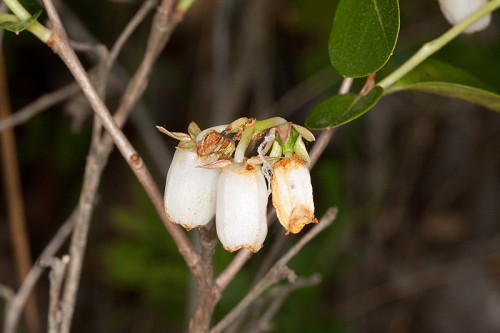Difference between revisions of "Lyonia mariana"
Emmazeitler (talk | contribs) |
Emmazeitler (talk | contribs) |
||
| Line 31: | Line 31: | ||
==Ecology== | ==Ecology== | ||
===Habitat=== | ===Habitat=== | ||
| − | Common habitats for ''L. mariana'' | + | Common habitats for ''L. mariana'' are pine flatwoods, savannas, pocosin-sandhill ecotones, and dry sandy woodlands.<ref name= "Weakley"> Weakley, A. S. (2015). Flora of the Southern and Mid-Atlantic States. Chapel Hill, NC, University of North Carolina Herbarium.</ref> These habitats largely occur in the Atlantic and Gulf Coastal Plain, Eastern Mountains, Great Plains, and the Northcentral and Northeast of the United States.<ref name= "USDA"> [https://plants.usda.gov/core/profile?symbol=CEAM USDA Plant Database]</ref> Specimens have been collected from habitats including dry sand oak woodland, pine flatwoods, thickets, dry sands in pine woodlands, wet flatwoods, dry sands near small ponds, cypress swamp edges, lakeside sand ridges, and pine palmetto flats.<ref name = "FSU herbarium"> URL: http://herbarium.bio.fsu.edu. Last accessed: June 2018. Collectors: R.K. Godfrey, Walter S. Judd, Kent Perkins, Scott Zona, Wilson Baker, Loran Anderson, Howard Home, K. Craddock Burks, George Cooley, R.J. Eaton, James D. Ray Jr., R.D. Houk, Sidney McDaniel, Gwynn W. Ramsey, Richard Mitchell, C. Jackson, Elias Potagas, K Lems, Robert Kral, R. A. Norris. States and counties: Florida (Leon, Taylor, Jefferson, Taylor, Franklin, Seminole, Madison, Gadsden, Putnam, Volusia, Wakulla) Georgia (Thomas)</ref> |
<!--Natural communities, human disturbed habitats, topography, hydrology, soils, light, fire regime requirements for removal of competition, etc.--> | <!--Natural communities, human disturbed habitats, topography, hydrology, soils, light, fire regime requirements for removal of competition, etc.--> | ||
<!--===Phenology===--> <!--Timing off flowering, fruiting, seed dispersal, and environmental triggers. Cite PanFlora website if appropriate: http://www.gilnelson.com/PanFlora/ --> | <!--===Phenology===--> <!--Timing off flowering, fruiting, seed dispersal, and environmental triggers. Cite PanFlora website if appropriate: http://www.gilnelson.com/PanFlora/ --> | ||
| Line 42: | Line 42: | ||
==Conservation and Management== | ==Conservation and Management== | ||
| − | ''L. mariana'' has been classified as endangered in Pennsylvania, | + | ''L. mariana'' has been classified as endangered in Pennsylvania, special concern in Connecticut, and historical in Rhode Island.<ref name= "USDA"> [https://plants.usda.gov/core/profile?symbol=CEAM USDA Plant Database]</ref> |
==Cultivation and restoration== | ==Cultivation and restoration== | ||
Revision as of 09:18, 28 September 2020
Common names: piedmont staggerbush[1]
| Lyonia mariana | |
|---|---|

| |
| Photo by the Southeastern Flora Database | |
| Scientific classification | |
| Kingdom: | Plantae |
| Division: | Magnoliophyta - Flowering plants |
| Class: | Magnoliopsida - Dicots |
| Order: | Ericales |
| Family: | Ericaceae |
| Genus: | Lyonia |
| Species: | L. mariana |
| Binomial name | |
| Lyonia mariana L. | |

| |
| Natural range of Lyonia mariana from USDA NRCS Plants Database. | |
Contents
Taxonomic Notes
Synonyms: Neopieris mariana (Linnaeus)
Varieties: none.[2]
Description
L. mariana is a perennial shrub of the Ericaceae family that is native to North America.[1] It is distinguishable by broadly elliptic leaves that grow at an upward 45-degree angle and bright pink axillary buds.[2]
Distribution
L. mariana ranges from Rhode Island and New York, south to the central peninsular and east Panhandle Florida. There are disjunct populations west of the Mississippi River in southcentral Missouri, central Arizona, northwestern Louisiana, southeastern Oklahoma, and eastern Texas.[2]
Ecology
Habitat
Common habitats for L. mariana are pine flatwoods, savannas, pocosin-sandhill ecotones, and dry sandy woodlands.[3] These habitats largely occur in the Atlantic and Gulf Coastal Plain, Eastern Mountains, Great Plains, and the Northcentral and Northeast of the United States.[1] Specimens have been collected from habitats including dry sand oak woodland, pine flatwoods, thickets, dry sands in pine woodlands, wet flatwoods, dry sands near small ponds, cypress swamp edges, lakeside sand ridges, and pine palmetto flats.[4]
Conservation and Management
L. mariana has been classified as endangered in Pennsylvania, special concern in Connecticut, and historical in Rhode Island.[1]
Cultivation and restoration
Photo Gallery
References and notes
- ↑ 1.0 1.1 1.2 1.3 USDA Plant Database
- ↑ 2.0 2.1 2.2 Weakley, A.S. 2015. Flora of the southern and mid-atlantic states. Working Draft of 21 May 2015. University of North Carolina at Chapel Hill, Chapel Hill, North Carolina.
- ↑ Weakley, A. S. (2015). Flora of the Southern and Mid-Atlantic States. Chapel Hill, NC, University of North Carolina Herbarium.
- ↑ URL: http://herbarium.bio.fsu.edu. Last accessed: June 2018. Collectors: R.K. Godfrey, Walter S. Judd, Kent Perkins, Scott Zona, Wilson Baker, Loran Anderson, Howard Home, K. Craddock Burks, George Cooley, R.J. Eaton, James D. Ray Jr., R.D. Houk, Sidney McDaniel, Gwynn W. Ramsey, Richard Mitchell, C. Jackson, Elias Potagas, K Lems, Robert Kral, R. A. Norris. States and counties: Florida (Leon, Taylor, Jefferson, Taylor, Franklin, Seminole, Madison, Gadsden, Putnam, Volusia, Wakulla) Georgia (Thomas)